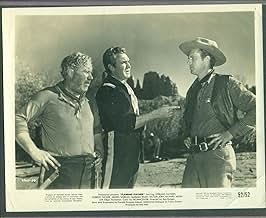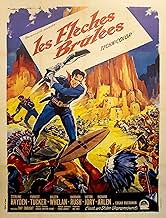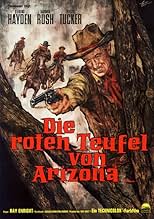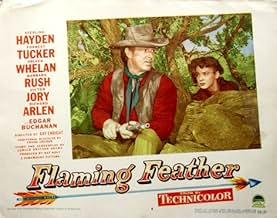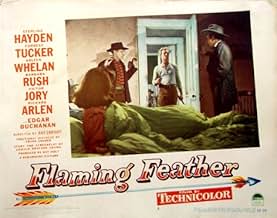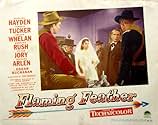IMDb RATING
5.8/10
460
YOUR RATING
In Arizona,during the 1870s, rancher Tex McCloud and cavalry Lt. Tom Blaine race to capture the famous renegade outlaw Ute leader known as the Sidewinder.In Arizona,during the 1870s, rancher Tex McCloud and cavalry Lt. Tom Blaine race to capture the famous renegade outlaw Ute leader known as the Sidewinder.In Arizona,during the 1870s, rancher Tex McCloud and cavalry Lt. Tom Blaine race to capture the famous renegade outlaw Ute leader known as the Sidewinder.
- Director
- Writers
- Stars
Victor Adamson
- Barfly
- (uncredited)
Carl Andre
- Trooper
- (uncredited)
Rudy Bowman
- Townsman
- (uncredited)
Buck Bucko
- Barfly
- (uncredited)
Paul E. Burns
- Gold Prospector
- (uncredited)
Heinie Conklin
- Townsman
- (uncredited)
Don Dunning
- Trooper Condon
- (uncredited)
- Director
- Writers
- All cast & crew
- Production, box office & more at IMDbPro
Featured reviews
Sterling Hayden stars as a cowboy who hits the trail in search of a renegade white man leading a band of Indians who burned his ranch and ran off his horses and cattle. The mysterious raider is responsible for the killing and looting of towns and wagon trains manages to elude the pursuing cavalry until events conspire to unmask the villain. Barbara Rush is the romantic interest of Hayden and also the renegade and her role is that of a damsel in distress throughout the picture. Forrest Tucker is good as an army lieutenant and there are comical exchanges between old timers Edgar Buchanan and George Cleveland. Victor Jury is also good as the dark, saturnine trading post owner. Arleen Whelan's role as a saloon singer doesn't have much to do with the film's plot but is quite a looker nonetheless. The technicolor is excellent, as is Paul Sawtell's spare music score.
"Flaming Feather", shot on location around Oak Creek Canyon near Sedona, Arizona, is a good example of a new type of Western which was becoming popular in the early fifties, using striking Technicolor photography of the magnificent scenery of the West as a backdrop to their stories. The Hollywood studios hoped that such films would become an important weapon in their battle against the new enemy, television, which at this stage could only show black-and-white pictures on a small screen.
The story centres upon a mysterious outlaw, known as the Sidewinder (after a species of poisonous snake). Although the Sidewinder is believed to be a white man, he leads a band of Ute Indians who have carried out a number of robberies. A rancher named Tex McCloud and a U.S. Cavalry officer named Tom Blaine both decide to bring the Sidewinder and his gang to justice and make a wager over which will get him first. There are a number of complications to the plot, including an attempt by a saloon entertainer named Carolina to persuade Tex to pursue Lucky Lee, a businessman and mine owner who allegedly owes her $20,000. (We never find out what this debt is for). Other important characters include Lucky's beautiful girlfriend Nora Logan, Turquoise, an Indian woman who is Nora's rival for Lucky's affections, a gambler named Showdown Calhoun and a mysterious figure named Tombstone Jack who is suspected of being the Sidewinder.
Some of the "new Westerns" of this period, such as the Mann/Stewart Western "The Naked Spur" were not just notable for striking photography but also brought to the genre a greater degree of character development and psychological analysis. Others, however, were beautiful to look at but their looks only served to hide a banal plot or second-rate acting. (I am thinking here of something like William Wellman's "Across the Wide Missouri", conceived as a large-scale epic, but so cut by the studio into something resembling a B-movie that Wellman virtually disowned it).
"Flaming Feather" falls somewhere between the two extremes. It does not have the depth of something like "The Naked Spur" or some of the other Mann/Stewart Westerns, but it is well-made and the plot, although complex, is always entertaining. There is no one outstanding star performance, but the acting is generally of a good standard. There is some very fine photography of the Arizona desert scenery. This is not quite in the first class of Westerns, but it is a good example of a second division one. 7/10
The story centres upon a mysterious outlaw, known as the Sidewinder (after a species of poisonous snake). Although the Sidewinder is believed to be a white man, he leads a band of Ute Indians who have carried out a number of robberies. A rancher named Tex McCloud and a U.S. Cavalry officer named Tom Blaine both decide to bring the Sidewinder and his gang to justice and make a wager over which will get him first. There are a number of complications to the plot, including an attempt by a saloon entertainer named Carolina to persuade Tex to pursue Lucky Lee, a businessman and mine owner who allegedly owes her $20,000. (We never find out what this debt is for). Other important characters include Lucky's beautiful girlfriend Nora Logan, Turquoise, an Indian woman who is Nora's rival for Lucky's affections, a gambler named Showdown Calhoun and a mysterious figure named Tombstone Jack who is suspected of being the Sidewinder.
Some of the "new Westerns" of this period, such as the Mann/Stewart Western "The Naked Spur" were not just notable for striking photography but also brought to the genre a greater degree of character development and psychological analysis. Others, however, were beautiful to look at but their looks only served to hide a banal plot or second-rate acting. (I am thinking here of something like William Wellman's "Across the Wide Missouri", conceived as a large-scale epic, but so cut by the studio into something resembling a B-movie that Wellman virtually disowned it).
"Flaming Feather" falls somewhere between the two extremes. It does not have the depth of something like "The Naked Spur" or some of the other Mann/Stewart Westerns, but it is well-made and the plot, although complex, is always entertaining. There is no one outstanding star performance, but the acting is generally of a good standard. There is some very fine photography of the Arizona desert scenery. This is not quite in the first class of Westerns, but it is a good example of a second division one. 7/10
With the ' threat ' of television Hollywood assessed the situation, and drew in audiences with 3D films, Cinemascope and above all colourful Westerns, and the latter could be made on simpler budgets and no doubt this ' new ' formula helped to keep the ' threat ' away. ' Flaming Feather ' directed well by Ray Enright in his penultimate film showed landscapes in rich Technicolour and good enough actors to draw audiences in. As for the plot a man called the Sideliner with the help of a renegade tribe raids on settlers, causing many deaths. No spoilers as to the motive. Sterling Hayden ( well acted ) has his ranch burned down and counter attacks. It really is as simple as that, and he of course falls in love with Barbara Rush in one of her earlier roles. The ending I saw a mile off, no doubt along with many children in the cinema. Basic the film is but it along with others heralded the way for the great Westerns of the 1950's to come. Just for the sweep of the action in mythical landscapes this film is worth seeing, and laconic Hayden is always well worth watching.
A band of renegade Utes, led by a sneaky, low down, forked tongue white man, burn, loot, and pillage across the southwest. A rugged settler and the Army go after the elusive skunk and his gang of dirty rats and meet in a blazing gun battle in the mountains. Above average western.
Presumably, the title relates to the Red Feather Saloon, and flaming-haired Arleen Whelan, who sometimes sings there. Arleen's character: Carolina, is your iconic 'bad' girl, as opposed to Barbara Rush's 'good' girl, Nora. They both have occasional incidents with the lead male: Sterling Hayden, as Tex. Tex saves Nora from great harm on several occasions. Thus, naturally, she is friendly with him. But, she also feels gratitude toward wealthy local, Lucky Lee, who looked after her, after her parents were killed and their house ransacked and burned by The Sidewinder and his band of renegade Utes, who have been the terror of Arizona Territory for 20 years! Now, Lucky has asked her to marry him, and she has accepted. However, Nora has also developed an obvious attraction to Tex, and worries about his safety. Meanwhile, Lucky has a beautiful Ute mistress in Turquoise(Carol Thurston), which doesn't seem to bother Nora. Turquoise thinks Lucky should marry her, but he says a man in his (exalted) position should marry his own kind.....
Caroline has an attraction/repulsion relationship with Tex. Sometimes, she tries to have him killed. Other times, she saves him from being killed. Sometimes she's angry at him. Other times, she proposes that they run off together. Caroline also has a thing going with cowboy Showdown((Richard Arlen). Most of these romantic conflicts will be resolved in the spectacular climax battle between The Sidewinder plus his Ute vs. most of those characters I've talked about, plus the US cavalry. This battle takes place in and around the Montezuma Castle Pueblo cliff dwellings, with a number of successive ladders to climb to the top......The main point of the story is the search for the identity of The Sidewinder, and eliminating him and his Utes......Some of the other characters include: Tombstone(Ian MacDonald): a shady gunslinger type, Forrest Tucker as Lt. Blaine, and his sidekick: Edgar Buchanan, as Sgt. O'Rourke. Another easily identified character actor is George Cleveland, who plays the aged Dr. Fallon: horse and people doctor, dentist, lawyer, justice of the peace, and no doubt a few other odd skills.......The location shooting takes place in various scenic areas of Arizona, and complements the 3 beautiful women included. You can see it all free, at YouTube
Did you know
- TriviaAccess to the interior of Montezuma's Castle has not been allowed to the public since 1951 for safety reasons and to protect the structures. At the end of the movie, cast members are seen climbing ladders up into the structure and some camera placement indicates that they were inside some of the rooms.
- GoofsWhen the Indians raid the ranch at the start of the movie all of the cattle in the stockade are Herefords. Herefords were not established as livestock in the western US until the 1880's when Charles Goodnight was finally able to breed them in the Texas panhandle a few other ranchers in the western US had tried in the late 1870's but all of those small herds died off after a short time.
- ConnectionsReferenced in Tous en scène ! (1953)
- SoundtracksAdios Mariquita Linda
(uncredited)
Written by Marcos Jimenez Sotelo
Details
- Runtime1 hour 17 minutes
- Aspect ratio
- 1.37 : 1
Contribute to this page
Suggest an edit or add missing content



